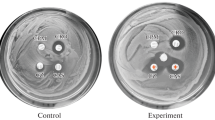Abstract
The clinical characterization of Bacillus amyloliquefacien contaminating 75% alcohol disinfectants were studied. The bacteria were cultured and observed by using bacterial examination under the hospital infection monitor. According to the regulations, the resistance of bacterial to physical and chemical factors was tested. Drug sensitivity tests for 20 commonly used medicines were carried out using a K-B method. The bacterial plasmids were analyzed using the Birnboim method. The bacteria were found after being cultured in the clinically-used 75% alcohol disinfectant fluid. Their total number was more than 800 cfu/mL and they were identified as Bacillus amyloliquefacien. The bacteria were also found to be resistant to boiling for 5 min. It grew well in 95% alcohol disinfectant and was insensitive to 84 disinfectant fluids containing chlorine (1000 mg/L) and such disinfectants as ozone. They were able to be sterilized better through routine ultraviolet exposure for 30 min or gas pressure. The bacteria contained a 2.5 kb plasmid and were sensitive to 13 drugs and insensitive to 7 drugs of the 20 drugs tested. It was suggested that alcohol disinfectant fluid was easily contaminated by Bacillus amyloliquefacien, and the bacteria was resistant to disinfectant fluids such as alcohol and 84 disinfectants.
Similar content being viewed by others
References
Pannifer A D, Wong T Y, Schwarzenbacher R, Renatus M, Petosa C, Bienkowska J, Lacy D B, Collier R J, Park S, Leppla S H, Hanna P, Liddington R C. Crystal structure of the anthrax lethal factor. Nature, 2001, 414(6860): 160–161
Mahadtanapuk S, Sanguansermsri M, Cutler R W, Sardsud V, Anuntalabhochai S. Control of anthracnose caused by colletotrichum musae on curcuma alismatifolia gagnep. Using antagonistic bacillus spp. Am J Agril Biol Sci, 2007, 2(2): 54–61
Matarante A, Baruzzi F, Cocconcelli P S, Morea M. Genotyping and toxigenic potential of bacillus subtilis and bacillus pumilus strains occurring in industrial and artisanal cured sausages. Appl Environ Microbiol, 2004, 70(9): 5168–5176
Nicholson W L, Munakata N, Horneck G, Melosh H J, Setlow P. Resistance of bacillus endospores to extreme terrestrial and extraterrestrial environments. Microbio Mol Biol Rev, 2000, 64(3): 548–572
Airaksinen U, Penttilä T, Wahlström E, Vuola J M, Puolakkainen M, Sarvas M. Production of chlamydia pneumoniae proteins in bacillus subtilis and their use in characterizing immune responses in the experimental infection model. Clin Diagn Lab Immunol, 2003, 10(3): 367–375
Zhang Z R. Clinical Microbiology and Examination of Microorganisms. Beijing: People’s Medcial Publishing House; 2002, 499–503 (in Chinese)
Weber D J, Saviteer S M, Rutala W A, Thomann C A. In vitro susceptibility of bacillus spp. to selected antimicrobial agents. Antimicrob Agents Chemother, 1988, 32(5): 642–645
Wu S X, Shen L. Plasmid analysis and phage typing in the study of staphylococcal colonization and disease in newborn infants. Zhonghua Yi Xue Za Zhi, 1993, 8: 157–161 (in Chinese)
Zhang W M, Wu S X, Liu G X. Study on amotile bacteria of positive blood culture in newborn: the analysis of plasmid and restriction enzyme and determination of outer membrane protein. Shiyong Erke Linchuang Zazhi, 1994, 9(5): 257–259 (in Chinese)
Zhang W M, Bian C L, Tu X Y, Wang L. Report on examining alcohol disinfectant fluid contamined by Bacillus amylolique-facien. Zhongguo Xiaoduxue Zazhi, 2006, 23(6): 579–580 (in Chinese)
Citron D M, Appleman M D. In vitro activities of daptomycin, ciprofloxacin, and other antimicrobial agents against the cells and spores of clinical isolates of bacillus species. J Clin Microbiol, 2006, 44(10): 3814–3818
Logan N A. Bacillus species of medical and veterinary importance. J Med Microbiol, 1988, 25(3): 157–165.
Esel D, Doganay M, Sumerkan B. Antimicrobial susceptibilities of 40 isolates of bacillus anthracis isolated in turkey. Int J Antimicrob Agents, 2003, 22(1): 70–72
Zhu M H, Bai P, Wang J F. Investigation into the Cause of Bacteria Contaminating Disinfectant Fluid in Use and its Control. Zhongguo Xiaoduxue Zazhi, 2005, 22(3): 315 (in Chinese)
Gao D Q. Synergism of alcohol in disinfection. Zhongguo Xiaoduxue Zazhi, 1993, 10(2): 101 (in Chinese)
Zhao G Z, Wang X, Yang J. Observation of the effect of sterilization education on the contamination of the bottles full of iodine and alcohol. Hulixue Zazhi, 2005, 20(5): 63 (in Chinese)
Author information
Authors and Affiliations
Corresponding author
Rights and permissions
About this article
Cite this article
Zhang, W., Yuan, Y., Bian, C. et al. Characterization of Bacillus amyloliquefacien contaminating 75% alcohol disinfectant. Front. Med. China 2, 113–116 (2008). https://doi.org/10.1007/s11684-008-0021-2
Received:
Accepted:
Published:
Issue Date:
DOI: https://doi.org/10.1007/s11684-008-0021-2




